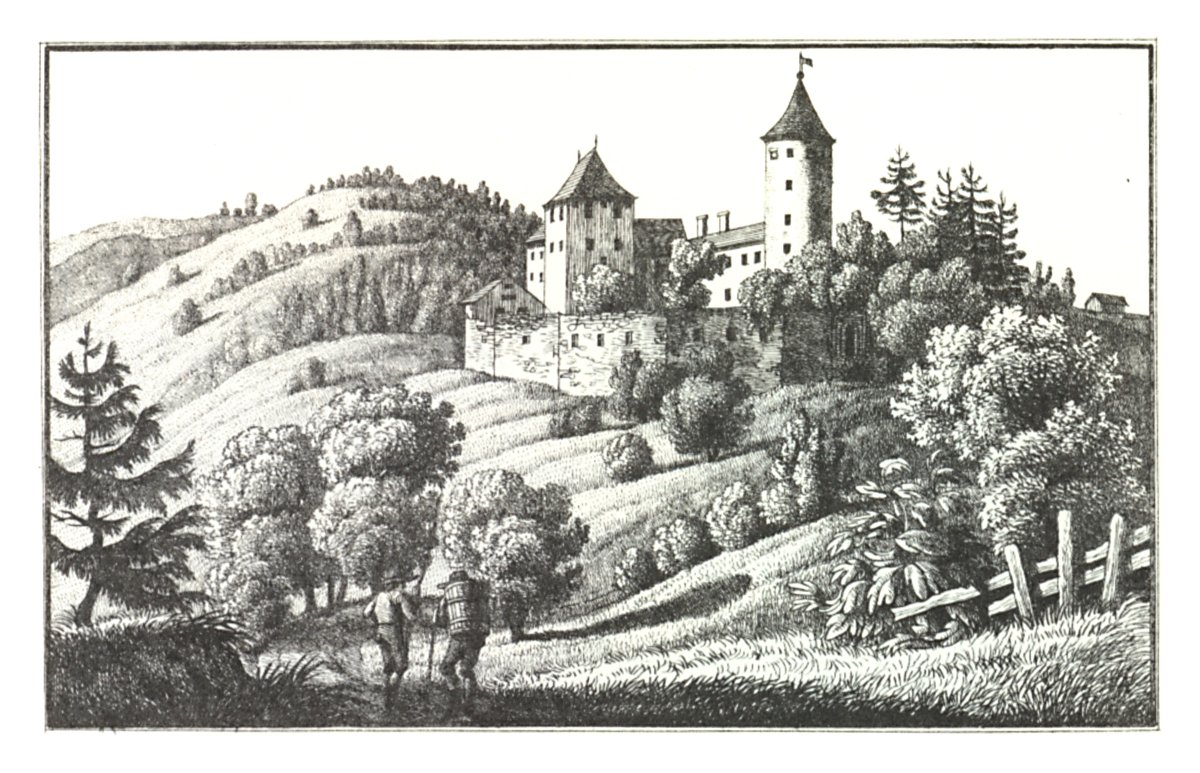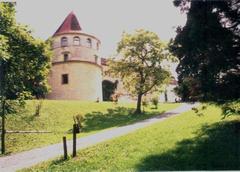
Burg Deutschlandsberg Visiting Hours, Tickets, and Historical Site Guide
Date: 04/07/2025
Introduction: The Legacy of Burg Deutschlandsberg
Set amidst the rolling hills of Styria, Austria, Burg Deutschlandsberg—also known as Landsberg Castle—stands as a monument to centuries of human history, architectural prowess, and regional culture. From its Neolithic origins and pivotal Iron Age fortifications to its medieval, Renaissance, and modern incarnations, the castle encapsulates the evolution of the region. Overlooking the Lassnitz River and the town that bears its name, Burg Deutschlandsberg today serves as both a preserved historical site and a dynamic cultural hub.
This guide provides essential visitor information on Burg Deutschlandsberg’s opening hours, ticketing, accessibility, guided tours, and nearby attractions. Within the castle, the Archeo Norico Museum offers fascinating exhibitions of prehistoric artifacts, medieval arms, and regional history. Visitors can also experience seasonal reenactments, educational workshops, and vibrant cultural festivals. For those seeking to extend their stay, the Renaissance Kuenburg wing’s boutique hotel presents an opportunity to immerse oneself in the castle’s unique ambiance.
Beyond the castle, Deutschlandsberg’s historic streets, renowned Styrian vineyards, picturesque hiking trails, and culinary delights await exploration. This comprehensive guide equips you with everything needed to plan an enriching visit to one of Styria’s most cherished landmarks. For the latest updates, consult the official Burg Deutschlandsberg and ArchaeoRegion Südweststeiermark websites (archeonorico.at, archaeoregion.at).
Table of Contents
- Introduction
- Visiting Burg Deutschlandsberg: Practical Information
- Historical Overview of Burg Deutschlandsberg
- Architectural Evolution and Features
- Cultural Significance and Community Role
- Travel Tips and Nearby Attractions
- Key Historical Sites and Local Attractions
- Frequently Asked Questions (FAQ)
- Plan Your Visit and Stay Connected
- Conclusion
Visiting Burg Deutschlandsberg: Practical Information
Visiting Hours
- April to October: Tuesday to Sunday, 9:00 AM – 6:00 PM
- November to March: Saturday and Sunday, 10:00 AM – 4:00 PM
Closed on Mondays and certain public holidays. Always confirm on the official website before visiting.
Tickets and Pricing
- Adults: €8
- Seniors (65+): €6
- Students (with valid ID): €5
- Children under 12: Free
- Family ticket (2 adults + 2 children): €20
Special rates apply for groups and guided tours. Tickets are available both on-site and online via the museum portal.
Accessibility
While the castle’s historic architecture means some sections are less accessible, major areas including the museum and event spaces are wheelchair accessible. Staff assistance is available upon request.
Guided Tours and Events
Guided tours are available daily during peak season and on weekends in the off-season, offering deep insights into the castle’s history and archaeological finds. The castle also hosts a calendar of seasonal events, workshops, and medieval reenactments. Check the official events calendar for current programs.
Historical Overview of Burg Deutschlandsberg
Prehistoric and Early Settlement
Archaeological findings at the “Tanzplatz” near the castle reveal continuous human activity from the Neolithic Lasinja culture (3900–3300 BCE) through the Copper Age and into the Hallstatt and La Tène periods. These early settlements underscore the strategic importance of the rocky spur on which the castle now stands (ermakvagus.com).
Roman and Early Medieval Developments
The area saw further development during Roman times and the early Middle Ages. In 970 CE, Emperor Otto I granted the region to the Archbishopric of Salzburg, initiating its long ecclesiastical administration (ermakvagus.com).
Foundation and Medieval Expansion
The first stone fortifications date to the early 12th century, under Archbishop Konrad I of Salzburg. By the late 12th century, the castle—then known as “castrum Lonsperch”—was a regional stronghold controlling key trade and military routes (ermakvagus.com).
Administrative and Judicial Role
From the 12th century until 1803, Burg Deutschlandsberg served as the administrative and judicial center of the Salzburg Archbishopric’s Styrian territories. It hosted the regional court district and enjoyed special privileges as an area of immunity (ermakvagus.com).
Renaissance Transformations and Modern Use
Significant Renaissance modifications were made in 1604, including the addition of the Kuenburg wing and a knight’s hall. After periods of occupation and decline, the Liechtenstein family owned the castle from 1820 until its purchase by the municipality in 1932. Modern restoration began in the mid-20th century, with further conservation and reopening of historic elements, such as the Romanesque tower and cistern, in the 21st century (ermakvagus.com, archeonorico.at).
Architectural Evolution and Historical Features
Origins and Historical Layers
Burg Deutschlandsberg’s architecture reflects its long history, with Romanesque foundations, Gothic additions, and Renaissance enhancements (archaeoregion.at). Early construction emphasized robust defensive features, later complemented by more elaborate residential and ceremonial spaces.
Defensive and Residential Structures
Key elements include a main keep, reconstructed polygonal tower (2012), and extensive ramparts. The castle’s cistern system ensured water supply during sieges. The Renaissance-era Kuenburg wing, now a boutique hotel, offers modern accommodations within a historic setting (castleandpalacehotels.com).
Religious and Cultural Spaces
The Gothic chapel, with its altar pedestal unearthed in modern excavations, once served the castle’s spiritual needs. The arcaded courtyard, a focal point for gatherings, now hosts exhibitions and festivals (touristplaces.guide).
Cultural Significance and Community Role
Administrative and Political History
As the region’s administrative seat for centuries, Burg Deutschlandsberg was central to local governance and defense, enduring numerous conflicts and changes in ownership. The castle’s symbolic status is underscored by its depiction in a 1681 engraving by Georg Matthäus Vischer (archaeoregion.at).
Museum and Exhibition Center
Today, Burg Deutschlandsberg houses the Archeo Norico museum, featuring collections from prehistory through the Renaissance, as well as temporary exhibitions, educational workshops, and archaeological research (archaeoregion.at, touristplaces.guide).
Venue for Cultural Events
The castle is a sought-after venue for concerts, art exhibitions, weddings, and festivals. Its historic halls and restaurant, which emphasizes regional cuisine, create a memorable setting for events (castleandpalacehotels.com).
Symbol of Regional Identity
Preserved and promoted by local organizations such as ArchaeoRegion Südweststeiermark, the castle remains a potent symbol of Styrian heritage (archaeoregion.at).
Travel Tips and Nearby Attractions
Getting There
Deutschlandsberg is easily reached by car (A2 highway, exit Lieboch B76) and train (connections from Graz), with local taxis available from the station (Travel to Austria).
Accommodation and Amenities
The Kuenburg wing’s boutique hotel features 24 double rooms, 2 single rooms, and 3 suites (including a Tower Suite), with rates from €68–250 (including breakfast and taxes). Amenities include a sauna and steam room.
Best Times to Visit
Late spring and early autumn offer mild weather and coincide with cultural events and festivals (touristplaces.guide).
Directions and Transport
Clear signage leads from Deutschlandsberg’s town center to the castle. Ample parking is available nearby.
Key Historical Sites and Local Attractions
- Archeo Norico Castle Museum: Inside Burg Deutschlandsberg, this museum covers the region’s history from prehistory to early modern times (whichmuseum.com).
- Bauernhausmuseum Herk: Explore rural Styrian tradition in a preserved farmhouse (whichmuseum.com).
- Feuerwehrmuseum Grub bei Groß Sankt Florian: Family-friendly exploration of firefighting history.
- Traktormuseum Stainz and Weinmuseum Kitzeck: Celebrate Styrian agriculture and wine culture.
Outdoor Activities
- Hiking and Cycling: Trails through the Koralpe mountains, vineyards, and forests (Komoot).
- Stausee Soboth: Lake for swimming, camping, and picnics.
- Mountain Huts: Rustic dining and scenic rest stops at places like Grünangerhütte.
Town Center and Gastronomy
- Hauptplatz Deutschlandsberg: Lively town square with cafés, shops, and seasonal events.
- Wine and Cuisine: Enjoy Styrian specialties such as pumpkin seed oil dishes and regional wines.
Family-Friendly Attractions
- Tier-, Wild- und Spielpark Preding: Wildlife and play park.
- Flascherlzug Stainz: Historic railway with scenic rides.
Scenic Viewpoints and Wellness
- Stainzer Warte Observation Tower: Panoramic views.
- Stainzer Johannisquelle: Mineral spring known for its wellness benefits.
Frequently Asked Questions (FAQ)
Q: What are the current opening hours of Burg Deutschlandsberg?
A: April–October: Tuesday–Sunday, 9:00 AM–6:00 PM; November–March: Saturday and Sunday, 10:00 AM–4:00 PM. Closed Mondays.
Q: How can I purchase tickets?
A: Buy tickets on-site or via the official museum website.
Q: Are guided tours available?
A: Yes, in multiple languages, daily during peak season and weekends otherwise.
Q: Is the castle accessible for people with mobility challenges?
A: Major areas are accessible, though some historic sections may be challenging.
Q: Can I stay overnight at the castle?
A: Yes, the Kuenburg wing offers boutique hotel accommodations (Housity).
Q: Are there family-friendly attractions?
A: Absolutely—see the wildlife park, historic railway, and family events.
Plan Your Visit and Stay Connected
To optimize your experience, consult the Deutschlandsberg tourism website and local event calendars (MeinBezirk). Download the Audiala app for real-time updates, audio guides, and detailed travel information.
Visual Highlights
All images feature descriptive alt tags for accessibility and SEO.
Conclusion: Embracing Styrian Heritage at Burg Deutschlandsberg
Burg Deutschlandsberg is a living testament to Austria’s layered history, offering visitors a rich tapestry of ancient roots, architectural marvels, and vibrant cultural life. Enhanced by modern amenities and engaging events, the castle and its surroundings provide something for every traveler—whether your interests lie in history, nature, gastronomy, or family fun. For the most rewarding experience, rely on official resources, mobile guides, and local expertise to make your visit truly memorable.
References
- Burg Deutschlandsberg: Visiting Hours, Tickets, History & Travel Guide to Deutschlandsberg’s Historic Castle
- Burg Deutschlandsberg Visiting Hours, Tickets & Historical Sites: Complete Visitor Guide
- Burg Deutschlandsberg Visiting Hours, Tickets, and Guide to Deutschlandsberg Historical Sites
- Deutschlandsberg Historical Sites and Attractions: Visiting Hours, Tickets, and Local Highlights
- Burg Deutschlandsberg Hotel



